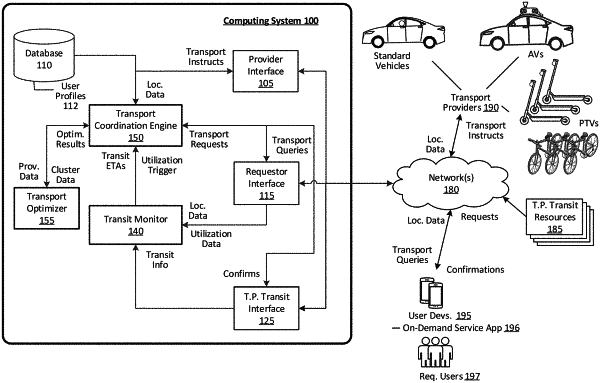| CPC G06Q 10/06311 (2013.01) [G06F 16/9035 (2019.01)] | 14 Claims |

|
1. A computing system implementing a transport service, the computing device comprising:
a network communication interface to communicate, over one or more networks, with computing devices of requesting users and transport providers utilizing the transport service;
one or more processors; and
a memory storing instructions that, when executed by the one or more processors, cause the computing system to:
receive, over the one or more networks, utilization data from the computing devices of the requesting users, wherein the utilization data corresponds to the computing devices of the requesting users operating an executing application, specific to the transport service, that transmits location data to the computing system;
process the utilization data by (i) executing a transit monitoring engine on the utilization data to detect a cluster of requesting users currently being transported by a third-party transit vehicle to an arrival location of the third-party transit vehicle, and (ii) executing a transport coordination engine on the utilization data to determine, for each requesting user in the cluster, an intent of the requesting user, the intent corresponding to a probability that the requesting user will utilize the transport service via the executing application upon arrival at the arrival location of the third-party transit vehicle;
based on the location data received from the computing devices of the cluster of requesting users, dynamically determine an estimated time of arrival of the third-party transit vehicle to the arrival location;
for each requesting user of the cluster of requesting users, determine a destination that requires additional transport from the arrival location of the third-party transit vehicle; and
based on (i) the destination of each requesting user of the cluster of requesting users, (ii) the estimated time of arrival of the third-party transit vehicle to the arrival location, and (iii) the determined intent of each requesting user to utilize the transport service, transmit, over the one or more networks, a set of transport facilitation requests to the computing devices of a selected set of the transport providers to facilitate transport for the cluster of requesting users at the arrival location of the third-party transit vehicle.
|